An Experimental and Simulation Study on Optimisation of the Operation of a Distributed Power Generation System with Energy Storage—Meeting Dynamic Household Electricity Demand
Abstract
:1. Introduction
2. System Design and Methodology
2.1. System Configuration
2.2. The Dynamic Electrical Loads
2.3. The Distributed Power Generation with Energy Storage System
2.3.1. The Generator
2.3.2. Battery
2.3.3. Supercapacitor
2.4. Data Acquisition System
2.5. Computer Simulation and Control Strategy of the System
2.6. System Optimisation Process
3. Results and Discussion
3.1. Summer Day Load
3.1.1. Experimental Result
3.1.2. Simulation Result
3.2. Winter Day
3.2.1. Experimental Result
3.2.2. Simulation Results
4. Optimisation Results and Discussion
5. Economic Analysis of the EG System
6. Conclusions
- From the experimental tests and the computational simulation on the DG-ES system, it is proved that the designed DG-ES can meet the selected 24-hours’ dynamic load demands with stable operation during either winter or summer.
- The maximum error of the two sets of simulation are 2.69% and 2.35%, respectively. The simulation of the system has successfully predicted the performance of the system.
- The performance of the DG-ES system can be improved through optimised operation process. The results showed that the energy saved was 3.61% in summer and 1.86% in winter, compared to the original operation arrangement.
Author Contributions
Funding
Acknowledgments
Conflicts of Interest
Nomenclature
| Power the primary energy can release | |
| Efficiency of engine | |
| Power of diesel engine generator | |
| Power of energy storage system | |
| Power of supercapacitor | |
| Power of batteries | |
| Energy demand of load | |
| Batteries’ state of charge | |
| At the end of operation time | |
| Batteries’ capacity | |
| DG-ES | Distributed power generation with energy storage system |
| t1 | Starting time of peak time zone 1 |
| t2 | Starting time of peak time zone 1 |
| top | Optimised time of engine operation |
| Generated Electromotive Force (EMF) in volts | |
| Air gap flux per pole in webers | |
| Angular velocity in radians per second | |
| Developed torque in newton-meters | |
| Armature current in amperes | |
| constant for the given machine | |
| Electrical efficiency of the engine | |
| The armature current of the engine | |
| dielectric constant | |
| the electric field intensity | |
| C | Volume of the supercapacitor |
| The operation voltage of the supercapacitor | |
| t1e | Ending time of peak time zone 1 |
| t2e | Ending time of peak time zone 1 |
References
- Clark, W.; Isherwood, W. Distributed generation: Remote power systems with advanced storage technologies. Energy Policy 2004, 32, 1573–1589. [Google Scholar] [CrossRef]
- Pepermans, G.; Driesen, J.; Haeseldonckx, D.; Belmans, R.; D’haeseleer, W. Distributed generation: Definition, benefits and issues. Energy Policy 2005, 33, 787–798. [Google Scholar] [CrossRef]
- Zubo, R.H.A.; Mokryani, G.; Rajamani, H.-S.; Aghaei, J.; Niknam, T.; Pillai, P. Operation and planning of distribution networks with integration of renewable distributed generators considering uncertainties: A review. Renew. Sustain. Energy Rev. 2018, 72, 1177–1198. [Google Scholar] [CrossRef]
- Theo, W.L.; Lim, J.S.; Ho, W.S.; Hashim, H.; Lee, C.T. Review of distributed generation (DG) system planning and optimisation techniques: Comparison of numerical and mathematical modelling methods. Renew. Sustain. Energy Rev. 2017, 67, 531–573. [Google Scholar] [CrossRef]
- Moreno-Munoz, A.; de-la-Rosa, J.J.G.; Lopez-Rodriguez, M.A.; Flores-Arias, J.M.; Bellido-Outerino, F.J.; Ruiz-de-Adana, M. Improvement of power quality using distributed generation. Int. J. Electr. Power Energy Syst. 2010, 32, 1069–1076. [Google Scholar] [CrossRef]
- Evangelisti, S.; Lettieri, P.; Clift, R.; Borello, D. Distributed generation by energy from waste technology: A life cycle perspective. Process Safety Environ. Prot. 2015, 93, 161–172. [Google Scholar] [CrossRef]
- Touretzky, C.R.; McGuffin, D.L.; Ziesmer, J.C.; Baldea, M. The effect of distributed electricity generation using natural gas on the electric and natural gas grids. Appl. Eng. 2016, 177, 500–514. [Google Scholar] [CrossRef]
- Abbassi, A.; Dami, M.A.; Jemli, M. A statistical approach for hybrid energy storage system sizing based on capacity distributions in an autonomous PV/Wind power generation system. Renew. Energy 2017, 103, 81–93. [Google Scholar] [CrossRef]
- Ho, W.S.; Macchietto, S.; Lim, J.S.; Hashim, H.; Muis, Z.A.; Liu, W.H. Optimal scheduling of energy storage for renewable energy distributed energy generation system. Renew. Sustain. Energy Rev. 2016, 58, 1100–1107. [Google Scholar] [CrossRef]
- Erdinc, O.; Paterakis, N.G.; Pappi, I.N.; Bakirtzis, A.G.; Catalão, J.P.S. A new perspective for sizing of distributed generation and energy storage for smart households under demand response. Appl. Eng. 2015, 143, 26–37. [Google Scholar] [CrossRef]
- Zheng, M.; Meinrenken, C.J.; Lackner, K.S. Smart households: Dispatch strategies and economic analysis of distributed energy storage for residential peak shaving. Appl. Eng. 2015, 147, 246–257. [Google Scholar] [CrossRef] [Green Version]
- Falke, T.; Krengel, S.; Meinerzhagen, A.-K.; Schnettler, A. Multi-objective optimization and simulation model for the design of distributed energy systems. Appl. Eng. 2016, 184, 1508–1516. [Google Scholar] [CrossRef]
- Wang, Y.; Ronilaya, F.; Chen, X.; Roskilly, A.P. Reprint of “Modelling and simulation of a distributed power generation system with energy storage to meet dynamic household electricity demand”. Appl. Thermal Eng. 2013, 53, 312–324. [Google Scholar] [CrossRef]
- Brandoni, C.; Renzi, M. Optimal sizing of hybrid solar micro-CHP systems for the household sector. Appl.Thermal Eng. 2015, 75, 896–907. [Google Scholar] [CrossRef]
- Widmann, C.; Lödige, D.; Toradmal, A.; Thomas, B. Enabling CHP units for electricity production on demand by smart management of the thermal energy storage. Appl. Thermal Eng. 2017, 114, 1487–1497. [Google Scholar] [CrossRef]
- Magnani, S.; Pezzola, L.; Danti, P. Design Optimization of a Heat Thermal Storage Coupled with a Micro-CHP for a Residential Case Study. Energy Procedia 2016, 101, 830–837. [Google Scholar] [CrossRef]
- Ebrahimi, M.; Keshavarz, A. 1-CCHP Literature. In Combined Cooling, Heating and Power; Elsevier: Boston, MA, USA, 2015; pp. 1–34. [Google Scholar]
- Bang-Møller, C.; Rokni, M.; Elmegaard, B.; Ahrenfeldt, J.; Henriksen, U.B. Decentralized combined heat and power production by two-stage biomass gasification and solid oxide fuel cells. Energy 2013, 58, 527–537. [Google Scholar] [CrossRef]
- Yagoub, W.; Doherty, P.; Riffat, S.B. Solar energy-gas driven micro-CHP system for an office building. Appl. Thermal Eng. 2006, 26, 1604–1610. [Google Scholar] [CrossRef]
- Antonucci, V.; Branchini, L.; Brunaccini, G.; de Pascale, A.; Ferraro, M.; Melino, F.; Orlandini, V.; Sergi, F. Thermal integration of a SOFC power generator and a Na–NiCl2 battery for CHP domestic application. Appl. Energy 2017, 185, 1256–1267. [Google Scholar] [CrossRef]
- Li, J.; Wang, X.; Zhang, Z.; le Blond, S.; Yang, Q.; Zhang, M.; Yuan, W. Analysis of a new design of the hybrid energy storage system used in the residential m-CHP systems. Appl. Energy 2017, 187, 169–179. [Google Scholar] [CrossRef] [Green Version]
- Yagoub, M.Y.A.; Swart, H.C.; Coetsee, E. Energy transfer study between Ce3+ and Tb3+ ions in a calcium fluoride crystal for solar cell applications. J. Luminesc. 2017, 187, 96–101. [Google Scholar] [CrossRef]
- McKenna, E.; McManus, M.; Cooper, S.; Thomson, M. Economic and environmental impact of lead-acid batteries in grid-connected domestic PV systems. Appl. Energy 2013, 104, 239–249. [Google Scholar] [CrossRef] [Green Version]
- Morin, B.; Hennessy, J.; Arora, P. 11-Developments in nonwovens as specialist membranes in batteries and supercapacitors A2—Kellie, George. In Advances in Technical Nonwovens; Woodhead Publishing: Cambridgeshire, UK, 2016; pp. 311–337. [Google Scholar]
- Zhang, S.; Xiong, R.; Cao, J. Battery durability and longevity based power management for plug-in hybrid electric vehicle with hybrid energy storage system. Appl. Energy 2016, 179, 316–328. [Google Scholar] [CrossRef]
- Chong, L.W.; Wong, Y.W.; Rajkumar, R.K.; Isa, D. Modelling and Simulation of Standalone PV Systems with Battery-supercapacitor Hybrid Energy Storage System for a Rural Household. Energy Procedia 2017, 107, 232–236. [Google Scholar] [CrossRef]
- Bogno, B.; Sawicki, J.-P.; Salame, T.; Aillerie, M.; Saint-Eve, F.; Hamandjoda, O.; Tibi, B. Improvement of safety, longevity and performance of lead acid battery in off-grid PV systems. Int. J. Hydrog. Energy 2017, 42, 3466–3478. [Google Scholar] [CrossRef]
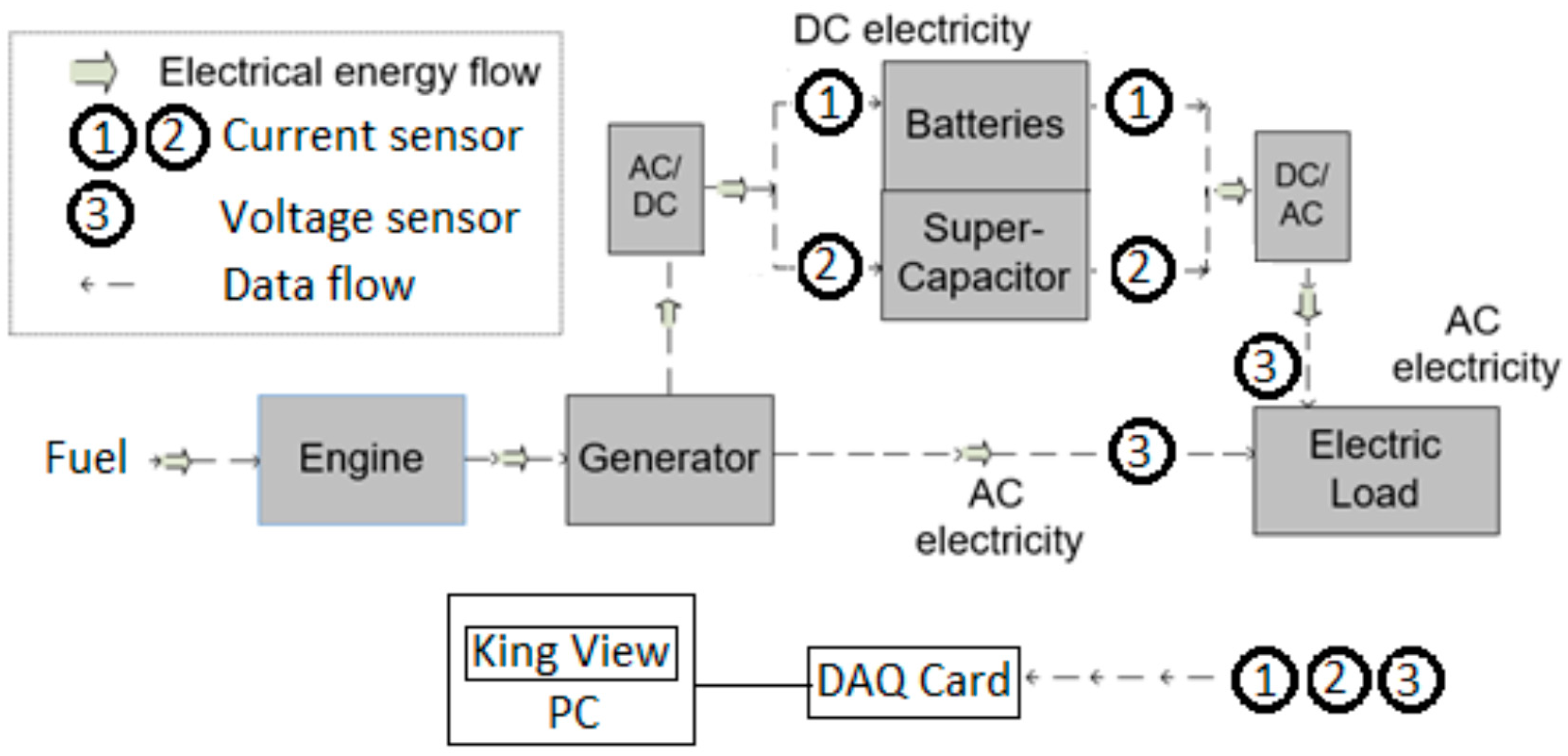
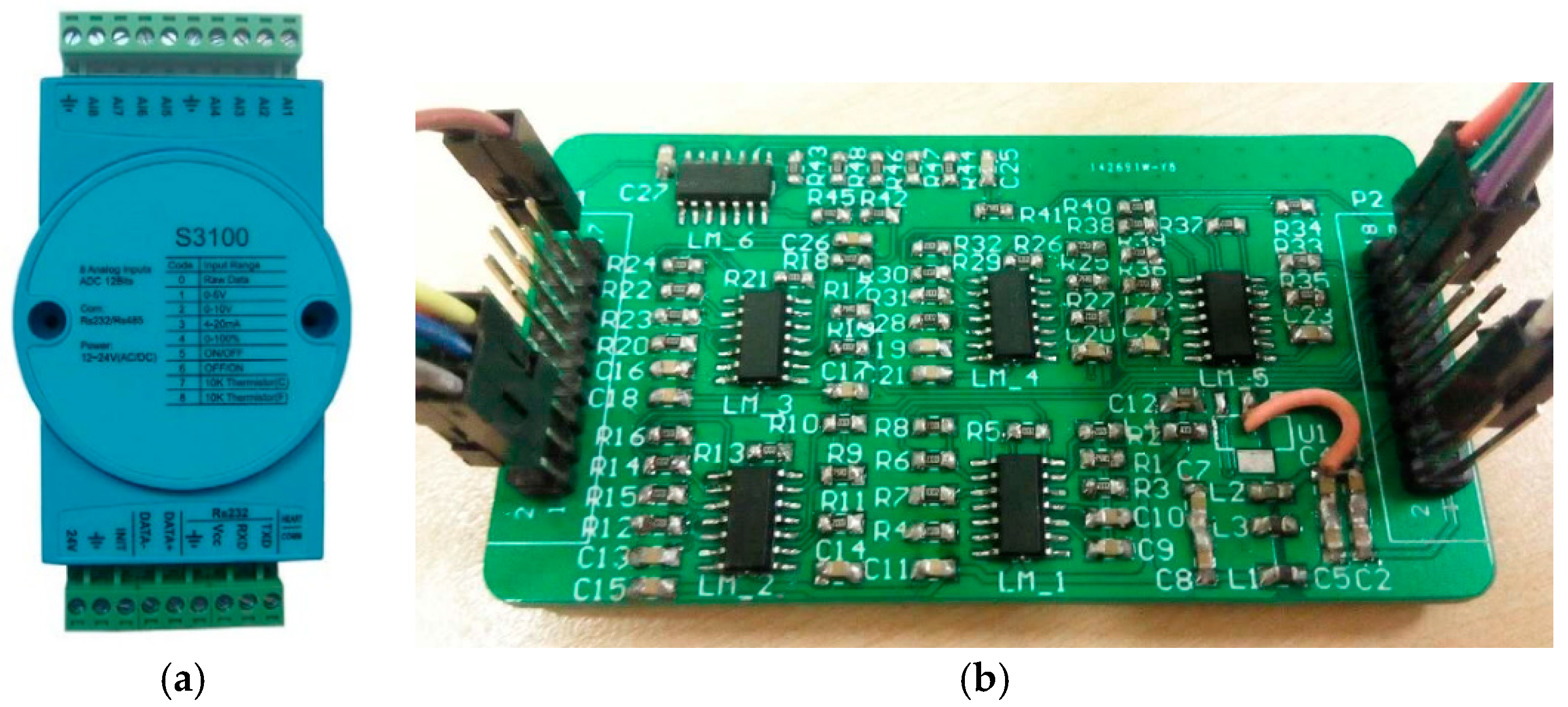
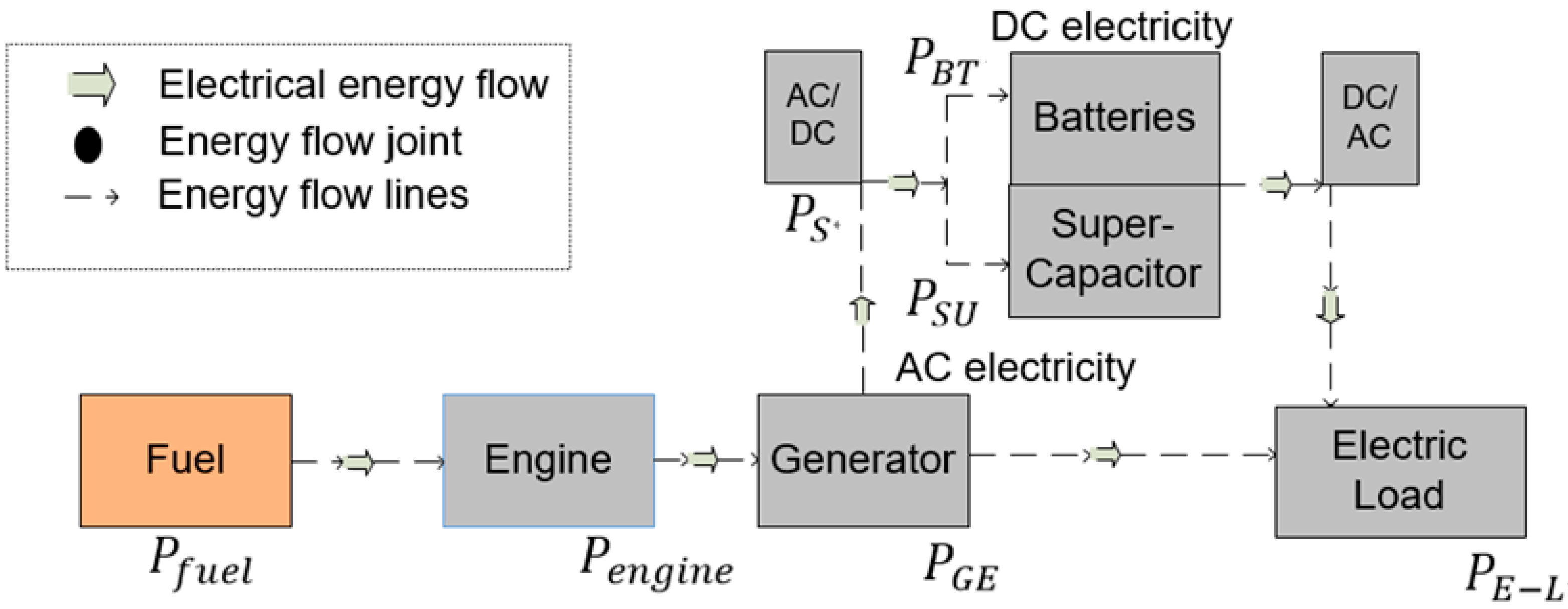
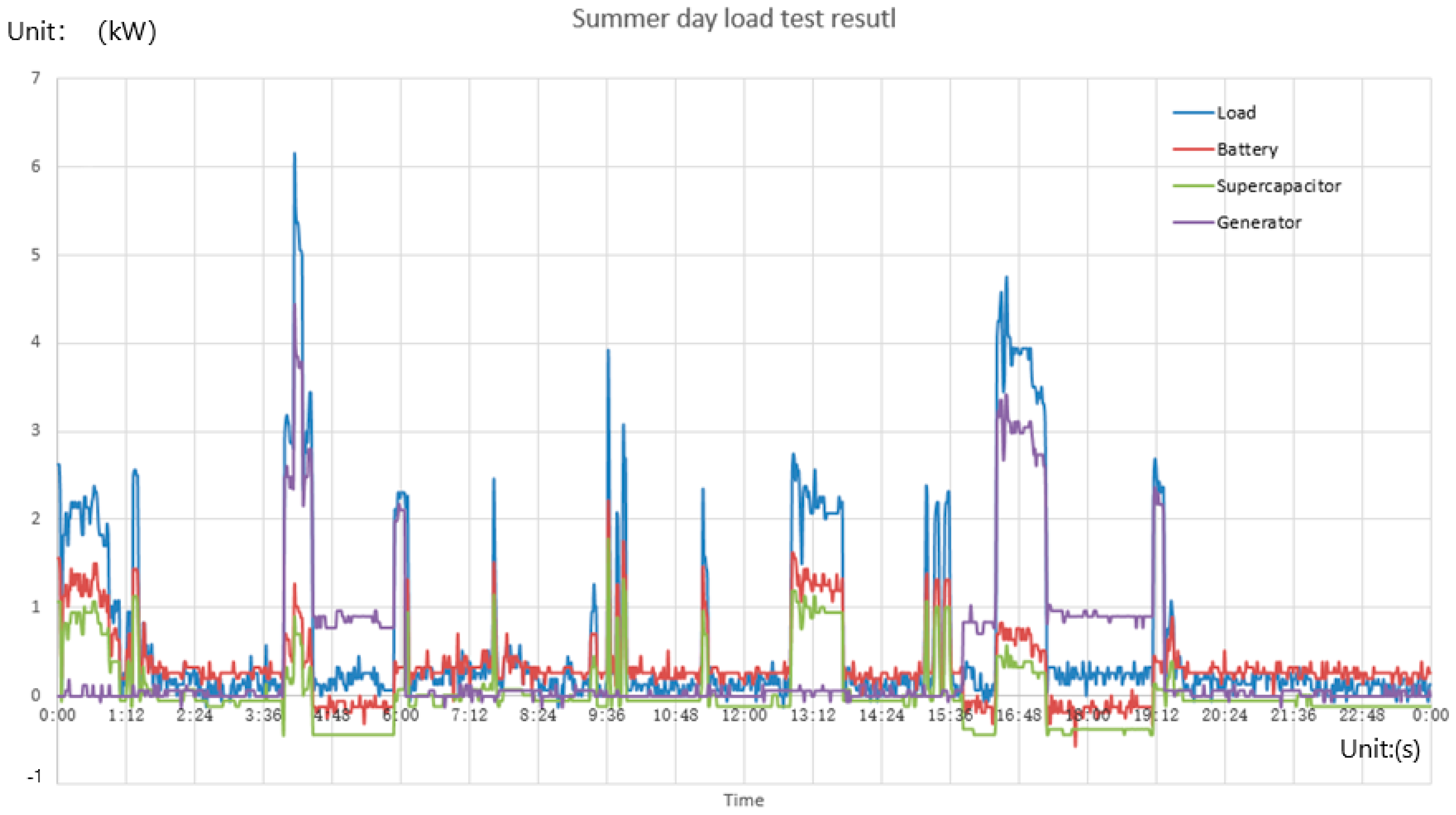
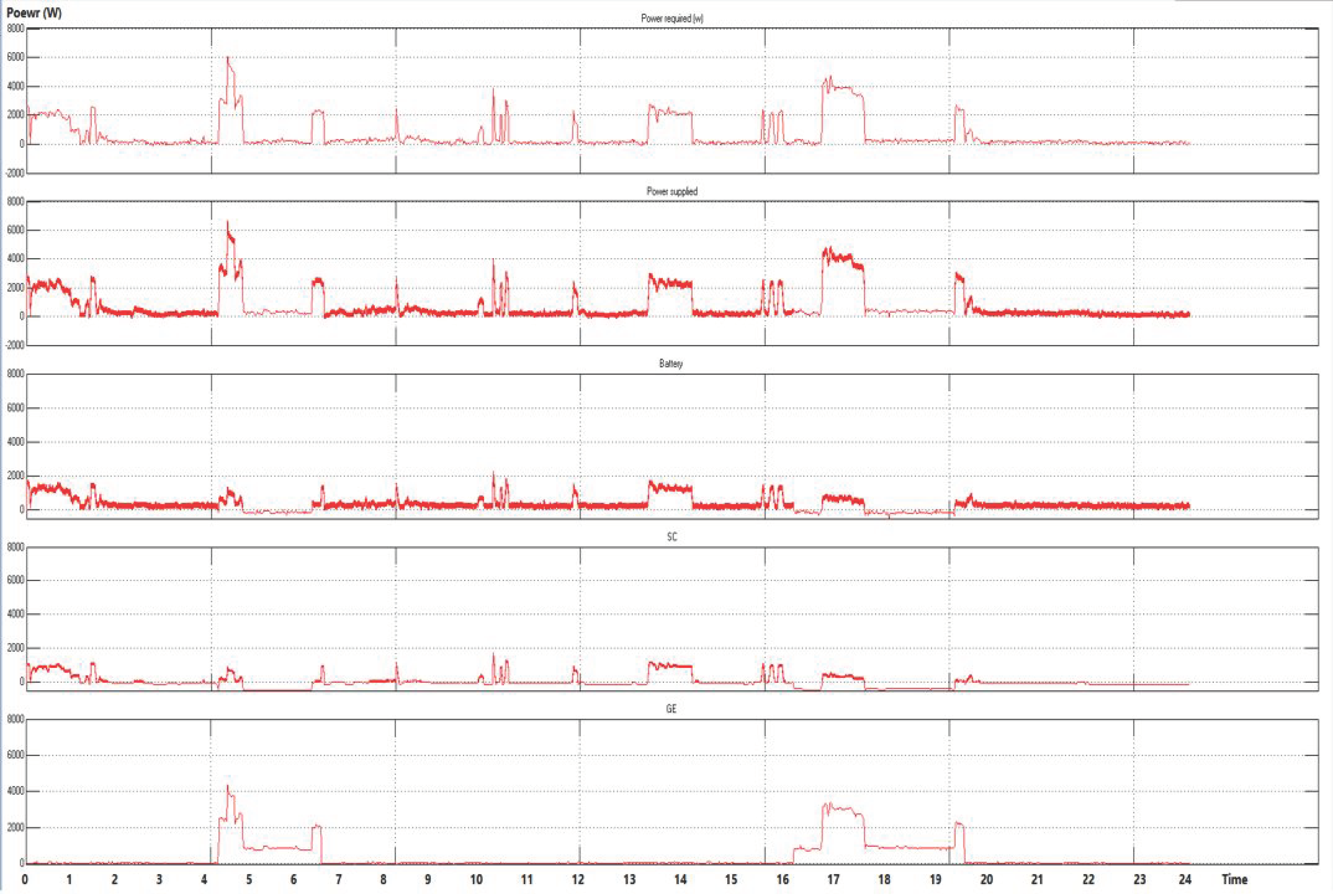

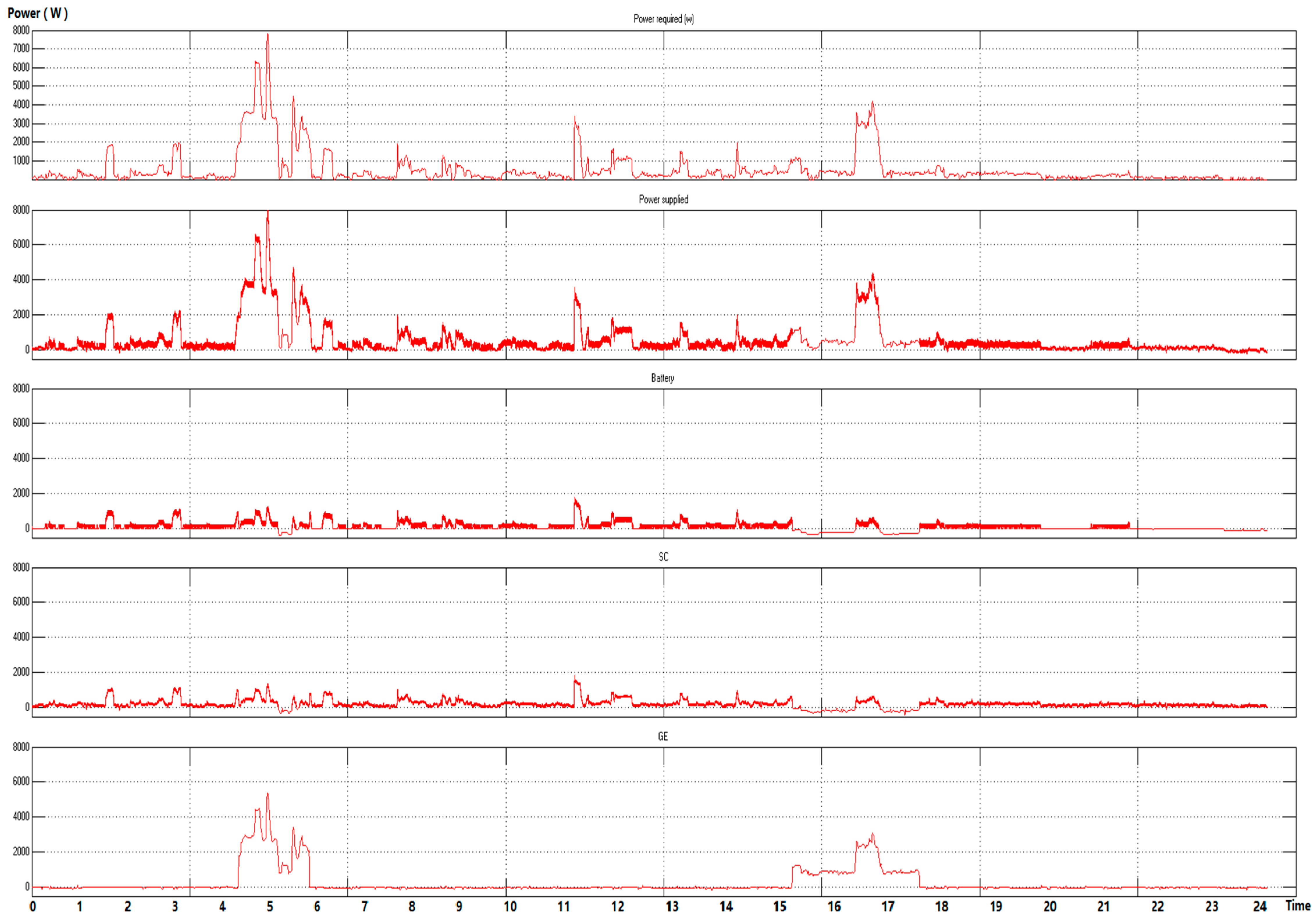
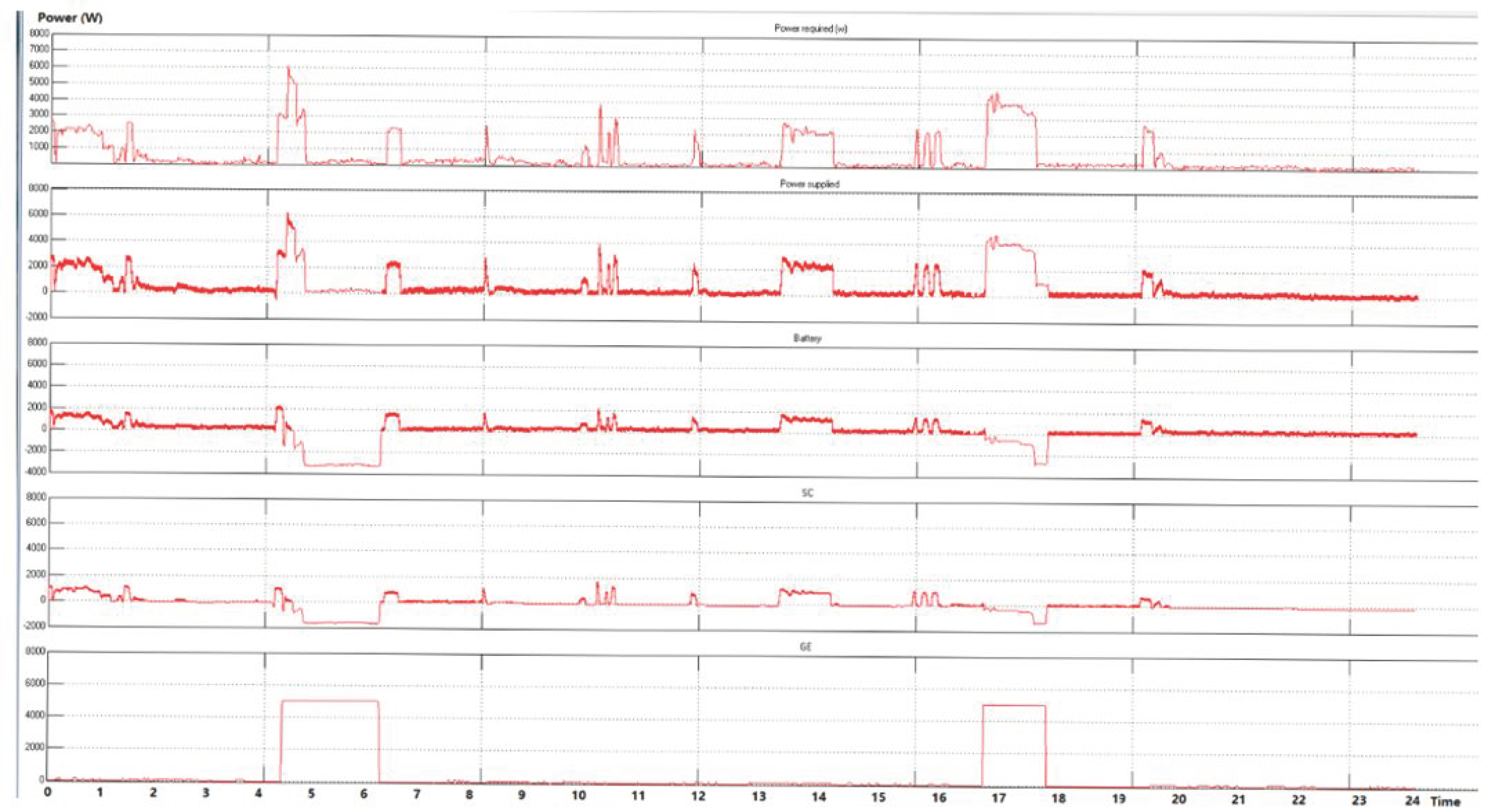
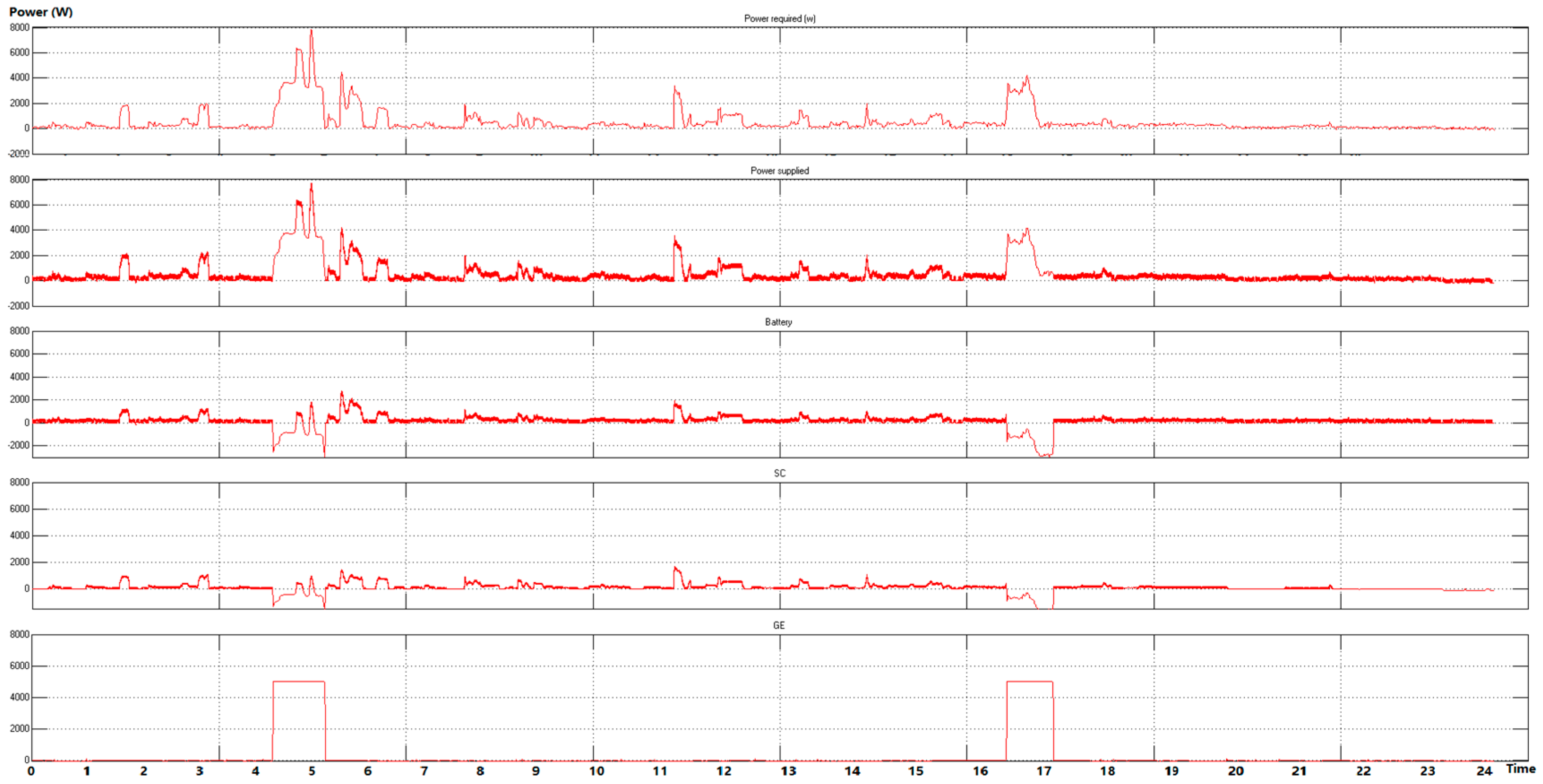
| Load of the Engine (%) | Engine Efficiency (%) | Error (%) |
|---|---|---|
| 0 | 0 | 0 |
| 10 | 7.8 | 1.13 |
| 25 | 16.36 | 0.36 |
| 50 | 24.3 | 0.41 |
| 75 | 27.53 | 0.82 |
| 100 | 28.5 | 1.42 |
| Core Parameters about System’s Operation | Summer Load | Winter Load |
|---|---|---|
| Energy required (kWh) | 9.76 | 7.28 |
| Energy supplied (kWh) | 9.81 | 7.36 |
| Energy supplied by the engine (kWh) | 7.38 | 4.33 |
| Energy supplied by the storage units (kWh) | 2.23 | 3.03 |
| Maximum battery power (kW) | 2.113 | 1.96 |
| Maximum supercapacitor power (kW) | 1.078 | 1.76 |
| Simulation error (%) | 2.69 | 2.35 |
| Previous engine working time (h) | 4 | 3.83 |
| Improved engine working time (h) | 1.47 | 0.86 |
| Energy saved by the optimization process (kWh) | 3.61 | 1.86 |
| Equipment Initial Cost | ||
|---|---|---|
| Diesel engine | 1350 £ | |
| Lead acid batteries 6 sets | 115 × 6 = 690 £ | |
| Supercapacitor 12 V 300 F | 1450 £ | |
| Control system for optimisation | 450 £ (including software and hardware) | |
| System construction | Fuel consumption | Cost of energy production |
| Centralized power generation plant | \ | 0.15 £/kWh |
| Diesel engine generator with CHP | 0.2 L/kWh | 0.262 |
| Diesel engine generator with ORC | 0.22 L/kWh | 0.288 |
© 2019 by the authors. Licensee MDPI, Basel, Switzerland. This article is an open access article distributed under the terms and conditions of the Creative Commons Attribution (CC BY) license (http://creativecommons.org/licenses/by/4.0/).
Share and Cite
Ji, J.; Xia, X.; Ni, W.; Teng, K.; Miao, C.; Wang, Y.; Roskilly, T. An Experimental and Simulation Study on Optimisation of the Operation of a Distributed Power Generation System with Energy Storage—Meeting Dynamic Household Electricity Demand. Energies 2019, 12, 1091. https://doi.org/10.3390/en12061091
Ji J, Xia X, Ni W, Teng K, Miao C, Wang Y, Roskilly T. An Experimental and Simulation Study on Optimisation of the Operation of a Distributed Power Generation System with Energy Storage—Meeting Dynamic Household Electricity Demand. Energies. 2019; 12(6):1091. https://doi.org/10.3390/en12061091
Chicago/Turabian StyleJi, Jie, Xin Xia, Wei Ni, Kailiang Teng, Chunqiong Miao, Yaodong Wang, and Tony Roskilly. 2019. "An Experimental and Simulation Study on Optimisation of the Operation of a Distributed Power Generation System with Energy Storage—Meeting Dynamic Household Electricity Demand" Energies 12, no. 6: 1091. https://doi.org/10.3390/en12061091





